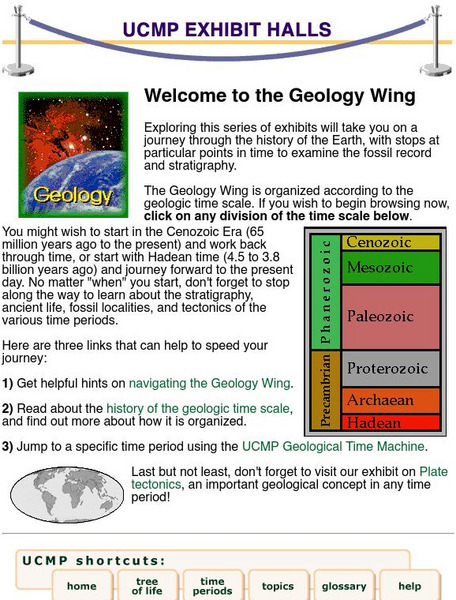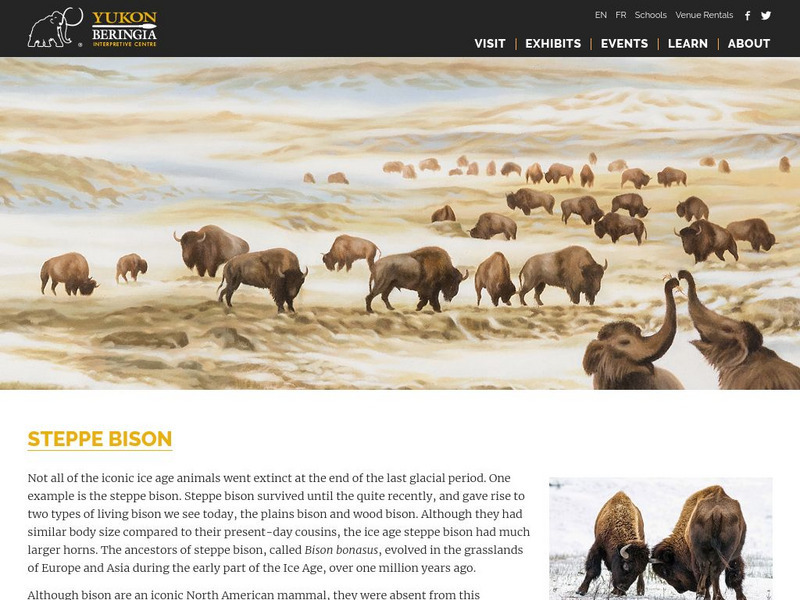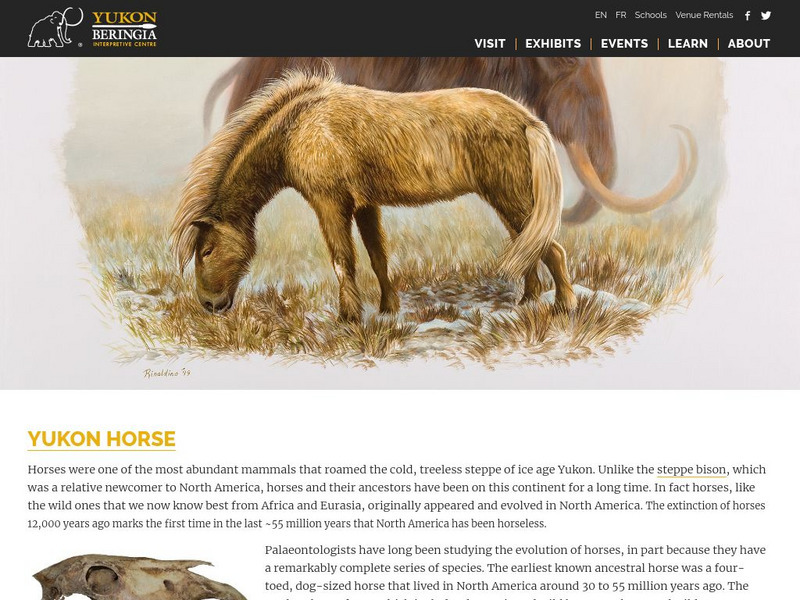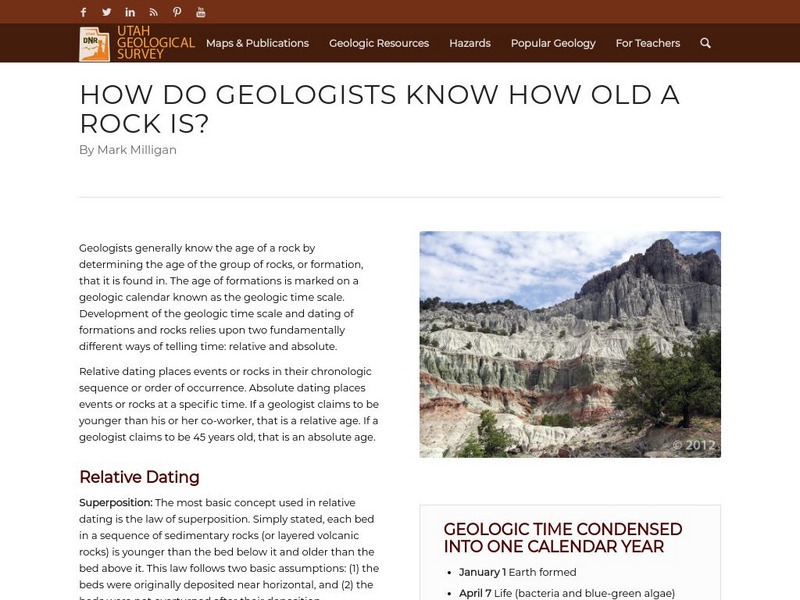Smithsonian Institution
National Museum of Natural History: David H. Koch Hall of Fossils: Deep Time
The Smithsonian Institution provides a virtual tour of the new "Deep Time" exhibit at the National Museum of Natural History.
US Geological Survey
U.s. Geological Survey: Geologic Time
A discussion of geologic time, how scientists use the concept, and how they have determined its span.
University of California
University of California Museum of Paleontology: Fossil Evidence
Understanding Evolution provides evidence for evolution using fossils. There are also links to lesson plans.
University of California
University of California Museum of Paleontology: Geology and Geologic Time
This site provides information about the geologic relationships of rock layers, as well as much about geologic time and the history of Earth.
US Geological Survey
Relative Time Scale
This is a good resource for anyone who wants to understand the historical development that led to our understanding of relative dating. This site also has links to index fossils and a table of geologic time.
University of California
Ucmp: A Relative Dating Activity
An learning activity to help learners grasp the concept of relative dating and geologic time.
US Geological Survey
The Numeric Time Scale
This is a good source for getting an in-depth description of using radioactive decay to measure the ages of rocks. In addition to describing the process of radiometric dating, this resource also includes a geologic time scale and four...
Other
Planetary Society: Relative and Absolute Ages in Histories of Earth and the Moon
A lengthy scholarly article that discusses the geologic time scale, its history of development, age-dating events that occurred in different eras, and how absolute and relative dating are used to assess the ages of the Earth and Moon....
Open Curriculum
Open Curriculum: Studying the History of Life
This in-depth article illustrates the concept of geologic time, and helps the learner understand why fossils are rare.
Other
Yukon Beringia Interpretive Centre: Research: Giant Short Faced Bear
Uncover discoveries from the past by learning about the prehistoric giant short-faced bear. Includes information about the time period, physical characteristics, fossil specimens, feeding habits, and habitat.
Other
Yukon Beringia Interpretive Centre: Research: Jefferson's Ground Sloth
Uncover discoveries from the past by learning about the prehistoric Jefferson's ground sloth. Includes information about the time period, physical characteristics, fossil specimens, feeding habits, and habitat.
Other
Yukon Beringia Interpretive Centre: Research: American Mastadon
Uncover discoveries from the past by learning about the prehistoric American mastodon. Includes information about the time period, physical characteristics, fossil specimens, feeding habits, and habitat.
Other
Yukon Beringia Interpretive Centre: Research: Giant Beaver
Uncover discoveries from the past by learning about the prehistoric giant beaver. Includes information about the time period, physical characteristics, fossil specimens, feeding habits, and habitat.
Other
Yukon Beringia Interpretive Centre: Research: Steppe Bison
Uncover discoveries from the past by learning about the prehistoric steppe bison. Includes information about the time period, physical characteristics, fossil specimens, feeding habits, and habitat.
Other
Yukon Beringia Interpretive Centre: Research: Yukon's Camels
Uncover discoveries from the past by learning about the prehistoric camels of the Yukon and Alaska. Includes information about the time period, physical characteristics, fossil specimens, feeding habits, and habitat.
Other
Yukon Beringia Interpretive Centre: Research: Ancient Caribou
Uncover discoveries from the past by learning about the prehistoric ancient caribou. Includes information about the time period, physical characteristics, fossil specimens, feeding habits, and habitat.
Other
Yukon Beringia Interpretive Centre: Research: Yukon Horse
Uncover discoveries from the past by learning about the prehistoric Yukon horse. Includes information about the time period, physical characteristics, fossil specimens, feeding habits, and habitat.
Other
Yukon Beringia Interpretive Centre: Research: Beringian Lion
Uncover discoveries from the past by learning about the prehistoric Beringian lion and the American lion that evolved from it. Includes information about the time period, physical characteristics, fossil specimens, feeding habits, and...
Other
Yukon Beringia Interpretive Centre: Research: Saiga Antelope
Uncover discoveries from the past by learning about the prehistoric North American saiga. Includes information about the time period, physical characteristics, fossil specimens, feeding habits, and habitat.
Other
Utah Geological Survey: How Do Geologists Know How Old a Rock Is?
Geologists generally know the age of a rock by determining the age of the group of rocks, or formation, that it is found in. The age of formations is marked on a geologic calendar known as the geologic time scale. Development of the...
Society for Science and the Public
Science News for Students: Carbon Dioxide Levels Rise Fast and High
The buildup of carbon dioxide in the atmosphere is rising faster than at any time since dinosaurs roamed the Earth. The burning of fossil fuels is largely to blame.
Other popular searches
- Geologic Time and Fossils
- Index Fossils Geologic Time
- Time Lines Fossils
- Fossils and Time Worksheets
- Geologic Time & Fossils Lab
- Fossils Geological Time Line




















